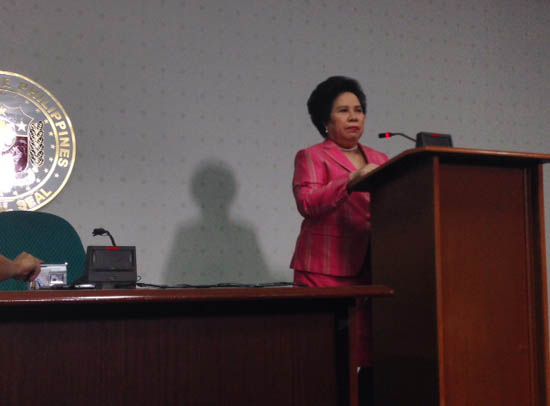Day 1 : Partnerships for Disaster and Climate Resilience #resilientPH
Natural hazards – storms, floods, earthquakes, volcanic eruptions, drought and landslides – occur regularly in the Philippines but disasters have increased in frequency and magnitude in recent years. The latest was Typhoon Yolanda (Haiyan) on November 8,2013.
The World Risk Report published by the United Nations University’s Institute for Environment and Human Security (UNU-EHS), the German Alliance for Development Works (Alliance), and The Nature Conservancy, ranked the Philippines as the third most disaster prone country among 173 countries in the world, behind Vanuatu and Tonga.
Compounding its vulnerability to extreme natural events, the Philippines has seen three times the global average in sea level rise. According to the World Meteorological Organization (WMO), the Philippines recorded the highest average increase in sea levels in 2013, at 60 centimeters against the global average of 19 centimeters since 1901. Rising sea levels is a “major force of nature” against which countries like the Philippines can do little. Disaster risk reduction, early warning systems and disaster preparedness can help but sea level rise poses a major additional risk .
Jean-Pascal van Ypersele, Vice-Chairman of the UN Intergovernmental Panel on Climate Change (IPCC), noted that the Philippines is greatly affected by rising sea levels around the world, and because of this, even stronger storms in the future could wreak more severe damage to the country. He stressed the need for the Philippines to take climate adaptation seriously in order to prepare itself for what are expected to be continuing major risks from climate change. “The Philippines can brace itself for the worst, but there’s no other way than to drastically change the way structures are built in the coastal areas. It’s to build a more resilient society, a more resilient infrastructure, an infrastructure made of housing, of buildings that resist better in extreme events with very high winds, very strong rain events. That is what is called adaptation to climate change and increasing the resilience,” van Ypersele said.
The Philippine Risk Reduction and Management Act (PRRMA) of 2010 defines resilience as “the ability of a system, community or society exposed to hazards to resist, absorb, accommodate and recover from the effects of a hazard in a timely and efficient manner, including through the preservation and restoration of its essential basic structures and functions.” More than preservation and restoration, resilience involves three elements: preparedness, adaptation and transformation. While effective disaster preparedness and climate change adaptation are essential to containing and coping with the adverse consequences of natural disasters, resilience requires a transformative change in the way society approaches natural hazards and climate change. It calls for a fundamental transformation in business models and mindsets regarding vulnerability in order to create a truly disaster and climate-resilient society.
Building a Resilient Society: Program Objectives
The proliferation of public and private sector initiatives and activities – shows that there is increased attention being given to building disaster and climate resilience in the Philippines. The private sector, in particular, has become increasingly involved in initiatives to make businesses more resilient to disasters and climate change and to contribute to national efforts at building a resilient society. While work is already underway in this regard, much more needs to be done.
It is in this context that the Carlos P. Romulo Foundation for Peace and Development, in cooperation with the Zuellig Family Foundation and the Manila Observatory, will launch a series of events over the next three years, beginning with a conference on July 9-10, 2014, to initiate and stimulate a continuing exchange of ideas and information on how best to build a resilient Philippine society. Beyond better disaster preparedness, risk reduction and climate change adaptation, the conference will give particular attention to the innovative and transformative changes needed to build resilience. The conference is expected to conclude with a statement highlighting the urgency of building a resilient society and proposing a set of concrete follow up measures to help achieve it.
The conference is expected to bring together officials of the Philippine government, experts and scholars, members of the diplomatic community, international organizations, business leaders, local and international NGOs, the media, and bilateral and multilateral aid agencies to explore more effective ways of building resilience in cities and communities throughout the country.
Following the July 2014 conference, the Carlos P. Romulo Foundation for Peace and Development, in cooperation with the Zuellig Family Foundation and the Manila Observatory, will undertake a series of follow-up activities over the next three years, including the convening of specialized workshops/roundtables, to review and assess progress, identify roadblocks and find ways to move forward on resilience across sectors and geographic areas.
It should be emphasized that the Carlos P. Romulo Foundation for Peace and Development as well as the Zuellig Family Foundation and the Manila Observatory see their role as convenors for multi-stakeholder dialogue and for bringing partners and parties together to act in concert on the basis of a shared approach to building a resilient society. Their aim is not to duplicate or take over the work being done by others in this field but to reinforce and add value to their efforts.
Over a period of three years, the follow-up activities will aim at:
1. Promoting and supporting multi-stakeholder dialogue on building a resilient Philippine society in the face of the country’s increased exposure and vulnerability to extreme natural events and climate change.
2. Generating heightened awareness on the urgency of building resilience and contributing to concerted and continuing advocacy for this purpose.
3. Promoting innovative approaches and solutions to resilience.
4. Supporting and reinforcing ongoing national and local initiatives and activities to build a resilient society.
5. Fostering the continuing exchange of experiences, lessons learned and best practices on resilience.
6. Supporting the mainstreaming of resilience into the country’s development plans, policies and programs
Conference objectives
The conference itself will seek to:
1. Develop a common understanding of “resilience”.
2. Review progress made by various stakeholders — the government, the private sector and business associations, foundations and other aid-giving organizations, the media, the academic community and technical and scientific institutions as well as international/regional organizations – on building resilience.
3. Identify new and innovative approaches and solutions to building resilience in various sectors – resources (water, food and energy), social services (health care, education and livelihood), and infrastructure (shelter, buildings, roads/bridges, information and communications) – and in cities and local communities with a view to developing a roadmap to resilience
4. Enlist the support of the media, including social media, to highlight the importance of building resilience.
5. Promote multi-stakeholder collaboration on the basis of a shared approach to resilience.
6. Agree on the follow-up events and activities over the next three years.
Here is Day 1 video playlist





